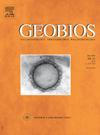A link of the Late Miocene giraffid migration pathway from the peri-Aegean lands to the northeastern Eurasian areas
IF 1.6
4区 地球科学
Q2 PALEONTOLOGY
引用次数: 0
Abstract
The southeastern retreat of the Paratethys Sea constrained by the Middle Sarmatian uplift of the last Eastern Carpathians nappe (Pericarpathian Nappe) caused the progressive emergence of land masses contiguous to the Dacian Basin. Diverse faunas, including large mammals, colonized these lands. However, giraffes remain poorly documented. This paper attests to the presence of giraffids documented by postcranial bones of Samotherium major and Helladotherium duvernoyi. So far, both genera have only been listed in Romania without any information about the retrieved fossil bones, description, or illustration. The fossils described herein – a metacarpal of Samotherium major and two metatarsals, and an astragalus of Helladotherium duvernoyi – were sampled from four Late Miocene outcrops of the Eastern Carpathians Foreland (Creţeşti 1, Văleni, Pogana and Fălciu). Two outcrops (Văleni and Fălciu) have just been discovered. Moreover, in this paper Samotherium major is described for the first time in Romania. During the Late Miocene, the giraffids were elemental components of the so-called Pikermian Biome of the Greco-Irano-Afghan Province. This biome extended from the peri-Aegean lands to Iran. However, several occurrences are known from northeastern Eurasian areas (Ukraine, Republic of Moldova, and Hungary). The new Romanian occurrences represent a link between the southern and northeastern giraffid faunas during the Late Miocene of eastern Europe, indicating a presumed migration pathway.
晚中新世长颈鹿从爱琴海沿岸到欧亚东北地区迁徙路径的链接
最后的东喀尔巴阡推覆体(Pericarpathian推覆体)的中萨尔马隆起限制了帕拉提提斯海的东南后退,导致了与达契亚盆地相邻的陆块的逐渐出现。各种各样的动物,包括大型哺乳动物,在这些土地上定居。然而,关于长颈鹿的文献仍然很少。本文通过大沙兽(Samotherium major)和大沙兽(Helladotherium duvernoyi)的颅后骨证明了长颈鹿的存在。到目前为止,这两个属只在罗马尼亚被列出,没有任何关于检索到的化石骨骼,描述或插图的信息。本文所描述的化石——大Samotherium的一个掌骨和两个跖骨,以及Helladotherium duvernoyi的一个黄龙骨——是从东喀尔巴阡山脉前陆(Creţeşti 1, valloleni, Pogana和fulciu)的四个晚中新世露头中采集的样本。刚刚发现了两个露头(vurileni和furilciu)。此外,本文首次在罗马尼亚描述了Samotherium major。在晚中新世,长颈鹿是希腊-伊朗-阿富汗省所谓的皮克米安生物群系的基本组成部分。这个生物群系从爱琴海沿岸延伸到伊朗。然而,在欧亚大陆东北部地区(乌克兰、摩尔多瓦共和国和匈牙利)也发现了一些病例。罗马尼亚的新发现代表了东欧晚中新世时期南部和东北部长颈鹿群之间的联系,表明了一个假定的迁徙途径。
本文章由计算机程序翻译,如有差异,请以英文原文为准。
求助全文
约1分钟内获得全文
求助全文
来源期刊

Geobios
地学-古生物学
CiteScore
3.30
自引率
6.20%
发文量
28
审稿时长
6-12 weeks
期刊介绍:
Geobios publishes bimonthly in English original peer-reviewed articles of international interest in any area of paleontology, paleobiology, paleoecology, paleobiogeography, (bio)stratigraphy and biogeochemistry. All taxonomic groups are treated, including microfossils, invertebrates, plants, vertebrates and ichnofossils.
Geobios welcomes descriptive papers based on original material (e.g. large Systematic Paleontology works), as well as more analytically and/or methodologically oriented papers, provided they offer strong and significant biochronological/biostratigraphical, paleobiogeographical, paleobiological and/or phylogenetic new insights and perspectices. A high priority level is given to synchronic and/or diachronic studies based on multi- or inter-disciplinary approaches mixing various fields of Earth and Life Sciences. Works based on extant data are also considered, provided they offer significant insights into geological-time studies.
 求助内容:
求助内容: 应助结果提醒方式:
应助结果提醒方式:


